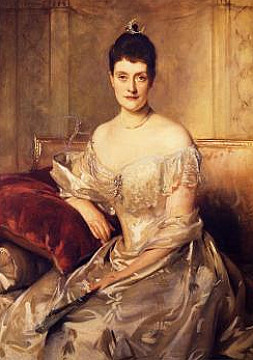Mary Morton (Hartpence) Sands (1853-1896)
Mrs "Minnie" Mary Morton (Hartpence) Sands
She was born to a clergyman in Indiana, but owed her introduction to society life to her uncle, U.S. Vice-President Levi P. Morton, in whose summer home at Newport, R.I., she was married to Mahlon Day Sands, in 1872. She was described as, "a woman of great beauty and social distinction, very prominent in the Prince of Wales' set in English society". It was the Prince who persuaded her to settle permanently in England from 1874, and as an intimate friend of the Princess of Wales (who she closely resembled in looks), twice they agreed to go to fancy dress balls wearing similar outfits, relishing in the confusion caused, it being impossible to tell one from the other.
Minnie had been a "faithful old friend" of Henry James since 1880 who remembered her as "that gracious lady". But the story that he based the personal qualities of the central character of his book Madame de Mauves on her is untrue, seeing as that book was published six years before they met. Frederick Townsend Martin was another particularly close friend of the Sands', and it was through them that he was first invited to Waddesdon Manor, the home of another of their intimate friends, Ferdy Rothschild. Martin described Minnie as, "a beautiful woman who possessed a great power of attraction". Her other notable friends included the portraitist John Singer Sargent who painted her in 1893.
Fred Martin recalled Minnie's distress after her husband's death in 1888: "(she) was one of those women who cannot exist without love. Her husband represented to her all that made life worth living and after he died she did not wish to live". On her deathbed in 1896, she still worried that she had spoilt his chance of a political career by asking him to remain in England. In addition to her stepdaughter, Mabel, they were the parents of three children - most notably the artist Ethel Sands. Minnie died at her home, 40 Portland Place, London. Fred Martin later wrote: "I do not think that the house in Portland Place will ever again have such charming occupants. I wonder whether personalities cling to houses...".
Minnie had been a "faithful old friend" of Henry James since 1880 who remembered her as "that gracious lady". But the story that he based the personal qualities of the central character of his book Madame de Mauves on her is untrue, seeing as that book was published six years before they met. Frederick Townsend Martin was another particularly close friend of the Sands', and it was through them that he was first invited to Waddesdon Manor, the home of another of their intimate friends, Ferdy Rothschild. Martin described Minnie as, "a beautiful woman who possessed a great power of attraction". Her other notable friends included the portraitist John Singer Sargent who painted her in 1893.
Fred Martin recalled Minnie's distress after her husband's death in 1888: "(she) was one of those women who cannot exist without love. Her husband represented to her all that made life worth living and after he died she did not wish to live". On her deathbed in 1896, she still worried that she had spoilt his chance of a political career by asking him to remain in England. In addition to her stepdaughter, Mabel, they were the parents of three children - most notably the artist Ethel Sands. Minnie died at her home, 40 Portland Place, London. Fred Martin later wrote: "I do not think that the house in Portland Place will ever again have such charming occupants. I wonder whether personalities cling to houses...".
Parents (2)
Categories
Share
Mahlon Sands' Obituary in The New York Times, May 9, 1888.
Things I Remember - Frederick Townsend Martin (1913)
https://www.pjharte.uk/commercial-fitout/40-portland-place
Image Courtesy of the Frick Art Reference Library
Things I Remember - Frederick Townsend Martin (1913)
https://www.pjharte.uk/commercial-fitout/40-portland-place
Image Courtesy of the Frick Art Reference Library




